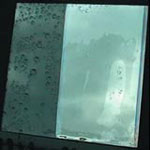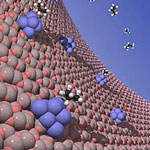Showing Spotlights 161 - 168 of 217 in category All (newest first):
 Self-cleaning, water and dirt-repellent coatings have differing properties, functional principles and manufacturing processes. Self-cleaning of the 'Lotus Effect' type has its basis in chemical-physical principles - these surfaces are characterised by a special roughness and are strongly water-repellent; in the ideal case, rain is sufficient for cleaning. 'Easy-to-Clean' materials, in contrast, have a particularly flat surface, which is both water and dirt-repellent on the basis of chemical aspects. Although the amount of mechanical cleaning may be reduced, they are not self-cleaning. A third form of self-cleaning is that based on photo catalysis by nano titanium dioxide. On such surfaces UV radiation produces oxygen radicals that decompose organic material, which in turn is removed in the rain by a water film.
Self-cleaning, water and dirt-repellent coatings have differing properties, functional principles and manufacturing processes. Self-cleaning of the 'Lotus Effect' type has its basis in chemical-physical principles - these surfaces are characterised by a special roughness and are strongly water-repellent; in the ideal case, rain is sufficient for cleaning. 'Easy-to-Clean' materials, in contrast, have a particularly flat surface, which is both water and dirt-repellent on the basis of chemical aspects. Although the amount of mechanical cleaning may be reduced, they are not self-cleaning. A third form of self-cleaning is that based on photo catalysis by nano titanium dioxide. On such surfaces UV radiation produces oxygen radicals that decompose organic material, which in turn is removed in the rain by a water film.
Jan 11th, 2011
 The OECD has just published a 111-page book on nanotechnology business that attempts to provide comprehensive, internationally comparable information on how different types of companies are affected by nanotechnology, how they use it in their innovative activities, how they acquire or develop relevant competences, as well as on the specific commercialization challenges they face. It also addresses the different role that new and small as well as larger companies will play in the commercialization of nanotechnology.The case studies provide qualitative insights into the commercialization of nanotechnology from the viewpoint of companies and thus complement studies which have relied primarily on publication and patent data or statistical surveys.
The OECD has just published a 111-page book on nanotechnology business that attempts to provide comprehensive, internationally comparable information on how different types of companies are affected by nanotechnology, how they use it in their innovative activities, how they acquire or develop relevant competences, as well as on the specific commercialization challenges they face. It also addresses the different role that new and small as well as larger companies will play in the commercialization of nanotechnology.The case studies provide qualitative insights into the commercialization of nanotechnology from the viewpoint of companies and thus complement studies which have relied primarily on publication and patent data or statistical surveys.
Jan 10th, 2011
 Global warming, caused by a build-up of greenhouse gases, in particular carbon dioxide, in the atmosphere, has led to numerous proposals on how to capture and store CO2 in order to mitigate the damaging emissions from fossil fuels. Today we take a look at carbon sequestration and subsequent storage in geological formations (geosequestration) - a proposal that is already being tested on a large scale. The idea behind coal-bed geosequestration is that you inject a huge amount of carbon dioxide into deep unmined coal seams. Due to strong adsorption forces, the carbon dioxide will be adsorbed in coal. It will not be desorbed and gradually transform to solid rocks. Moreover the technology is already developed and in use for oil and gas mining. However, the fundamental problem is so-called adsorption-induced deformation of coal or any other porous material.
Global warming, caused by a build-up of greenhouse gases, in particular carbon dioxide, in the atmosphere, has led to numerous proposals on how to capture and store CO2 in order to mitigate the damaging emissions from fossil fuels. Today we take a look at carbon sequestration and subsequent storage in geological formations (geosequestration) - a proposal that is already being tested on a large scale. The idea behind coal-bed geosequestration is that you inject a huge amount of carbon dioxide into deep unmined coal seams. Due to strong adsorption forces, the carbon dioxide will be adsorbed in coal. It will not be desorbed and gradually transform to solid rocks. Moreover the technology is already developed and in use for oil and gas mining. However, the fundamental problem is so-called adsorption-induced deformation of coal or any other porous material.
Nov 30th, 2010
 The automotive sector is a major consumer of material technologies - and nanotechnologies promise to improve the performance of existing technologies significantly. Applications range from already existing - paint quality, fuel cells, batteries, wear-resistant tires, lighter but stronger materials, ultra-thin anti-glare layers for windows and mirrors - to the futuristic - energy-harvesting bodywork, fully self-repairing paint, switchable colors, shape-shifting skin. The basic trends that nanotechnology enables for the automobile are: lighter but stronger materials; improved engine efficiency and fuel consumption for gasoline-powered cars; reduced environmental impact from hydrogen and fuel cell-powered cars; improved and miniaturized electronic systems; and better economies. This article provides an overview of a large number of efforts and applications involving nanotechnologies in the automotive industry.
The automotive sector is a major consumer of material technologies - and nanotechnologies promise to improve the performance of existing technologies significantly. Applications range from already existing - paint quality, fuel cells, batteries, wear-resistant tires, lighter but stronger materials, ultra-thin anti-glare layers for windows and mirrors - to the futuristic - energy-harvesting bodywork, fully self-repairing paint, switchable colors, shape-shifting skin. The basic trends that nanotechnology enables for the automobile are: lighter but stronger materials; improved engine efficiency and fuel consumption for gasoline-powered cars; reduced environmental impact from hydrogen and fuel cell-powered cars; improved and miniaturized electronic systems; and better economies. This article provides an overview of a large number of efforts and applications involving nanotechnologies in the automotive industry.
Nov 12th, 2010
 Nanocatalysis - the use of nanoparticles to catalyze reactions - is a rapidly growing field which involves the use of nanomaterials as catalysts for a variety of homogeneous and heterogeneous catalysis applications. Heterogeneous catalysis represents one of the oldest commercial practices of nanoscience; nanoparticles of metals, semiconductors, oxides, and other compounds have been widely used for important chemical reactions. Since nanoparticles have a large surface-to-volume ratio compared to bulk materials, they are attractive candidates for use as catalysts. Although surface science studies have contributed significantly to our fundamental understanding of catalysis, most commercial catalysts, are still produced by 'mixing, shaking and baking' mixtures of multi-components; their nanoscale structures are not well controlled and the synthesis-structure-performance relationships are poorly understood.
Nanocatalysis - the use of nanoparticles to catalyze reactions - is a rapidly growing field which involves the use of nanomaterials as catalysts for a variety of homogeneous and heterogeneous catalysis applications. Heterogeneous catalysis represents one of the oldest commercial practices of nanoscience; nanoparticles of metals, semiconductors, oxides, and other compounds have been widely used for important chemical reactions. Since nanoparticles have a large surface-to-volume ratio compared to bulk materials, they are attractive candidates for use as catalysts. Although surface science studies have contributed significantly to our fundamental understanding of catalysis, most commercial catalysts, are still produced by 'mixing, shaking and baking' mixtures of multi-components; their nanoscale structures are not well controlled and the synthesis-structure-performance relationships are poorly understood.
Nov 5th, 2010
 A new 290-page tome titled 'Strategic impact, no revolution' is the result of a year-long effort to study the strategic value and impact of NMP in its wider European and international context, with special focus on the ERA dimension, against the general policy objectives of FP6 and against the specific objectives of NMP. The title of this report refers to the general finding that the third thematic priority in FP6 strategically affected Europe's competitive position and was an important programme which also influenced Member States' policies and research agendas. However, it cannot be directly linked to a revolution with regard to creating substantial scientific or industrial breakthroughs although these were among the explicitly targeted objectives. The program strengthened Europe's position as one of the world leaders in the respective scientific and industrial fields, but did not enable Europe to outperform other key actors such as the United States or Japan.
A new 290-page tome titled 'Strategic impact, no revolution' is the result of a year-long effort to study the strategic value and impact of NMP in its wider European and international context, with special focus on the ERA dimension, against the general policy objectives of FP6 and against the specific objectives of NMP. The title of this report refers to the general finding that the third thematic priority in FP6 strategically affected Europe's competitive position and was an important programme which also influenced Member States' policies and research agendas. However, it cannot be directly linked to a revolution with regard to creating substantial scientific or industrial breakthroughs although these were among the explicitly targeted objectives. The program strengthened Europe's position as one of the world leaders in the respective scientific and industrial fields, but did not enable Europe to outperform other key actors such as the United States or Japan.
Aug 12th, 2010
 Here is a perfect example of how someone, who apparently doesn't understand or care much about the science, writes a sensational press release hyping nanotechnology by cherry-picking information and distorting issues. And all that to sell a product that doesn't even have to do with nanotechnology. Two days ago we ran a press release from Thomson Reuters about a brief report they compiled on patent data relating to nanotechnology in the cosmetics industry. Now, Thomson Reuters is in the business of selling information and information services products and applications. Their press release basically is advertising for their IP Market Reports. There is nothing wrong with that. What is very wrong, though, is the nonsense and unbalanced take on certain aspects on nanotechnologies. Let's take a closer look.
Here is a perfect example of how someone, who apparently doesn't understand or care much about the science, writes a sensational press release hyping nanotechnology by cherry-picking information and distorting issues. And all that to sell a product that doesn't even have to do with nanotechnology. Two days ago we ran a press release from Thomson Reuters about a brief report they compiled on patent data relating to nanotechnology in the cosmetics industry. Now, Thomson Reuters is in the business of selling information and information services products and applications. Their press release basically is advertising for their IP Market Reports. There is nothing wrong with that. What is very wrong, though, is the nonsense and unbalanced take on certain aspects on nanotechnologies. Let's take a closer look.
Jul 15th, 2010
 Tailing after emerging nanotechnology applications in biomedical and electronic industries, the construction industry recently started seeking out a way to advance conventional construction materials using a variety of manufactured nanomaterials. The use of nanotechnology materials and applications in the construction industry should be considered not only for enhancing material properties and functions but also in the context of energy conservation. This is a particularly important prospect since a high percentage of all energy used (e.g., 41% in the United States) is consumed by commercial buildings and residential houses by applications such as heating, lighting, and air conditioning. A recent review by scientists at Rice University has looked at the benefits of using nanomaterials in construction materials but also highlights the potentially harmful aspects of releasing nanomaterials into the environment.
Tailing after emerging nanotechnology applications in biomedical and electronic industries, the construction industry recently started seeking out a way to advance conventional construction materials using a variety of manufactured nanomaterials. The use of nanotechnology materials and applications in the construction industry should be considered not only for enhancing material properties and functions but also in the context of energy conservation. This is a particularly important prospect since a high percentage of all energy used (e.g., 41% in the United States) is consumed by commercial buildings and residential houses by applications such as heating, lighting, and air conditioning. A recent review by scientists at Rice University has looked at the benefits of using nanomaterials in construction materials but also highlights the potentially harmful aspects of releasing nanomaterials into the environment.
Jul 13th, 2010
 Self-cleaning, water and dirt-repellent coatings have differing properties, functional principles and manufacturing processes. Self-cleaning of the 'Lotus Effect' type has its basis in chemical-physical principles - these surfaces are characterised by a special roughness and are strongly water-repellent; in the ideal case, rain is sufficient for cleaning. 'Easy-to-Clean' materials, in contrast, have a particularly flat surface, which is both water and dirt-repellent on the basis of chemical aspects. Although the amount of mechanical cleaning may be reduced, they are not self-cleaning. A third form of self-cleaning is that based on photo catalysis by nano titanium dioxide. On such surfaces UV radiation produces oxygen radicals that decompose organic material, which in turn is removed in the rain by a water film.
Self-cleaning, water and dirt-repellent coatings have differing properties, functional principles and manufacturing processes. Self-cleaning of the 'Lotus Effect' type has its basis in chemical-physical principles - these surfaces are characterised by a special roughness and are strongly water-repellent; in the ideal case, rain is sufficient for cleaning. 'Easy-to-Clean' materials, in contrast, have a particularly flat surface, which is both water and dirt-repellent on the basis of chemical aspects. Although the amount of mechanical cleaning may be reduced, they are not self-cleaning. A third form of self-cleaning is that based on photo catalysis by nano titanium dioxide. On such surfaces UV radiation produces oxygen radicals that decompose organic material, which in turn is removed in the rain by a water film.
 Subscribe to our Nanotechnology Spotlight feed
Subscribe to our Nanotechnology Spotlight feed





